
Roofing Sheets: Their Uses
November 16th, 2023
Category: All Blogs, General
Roofing sheets have become an indispensable element in the construction industry, offering a versatile and durable solution for various structures. These sheets, typically made from materials like metal, plastic, or composite substances, have evolved beyond their traditional role of providing shelter. Today, these sheets serve as an integral component in creating sustainable and aesthetically pleasing buildings.
Let’s delve into the multifaceted uses of these sheets and their impact on modern construction practices.
- Weather Protection: At its core, the primary function of these sheets is to shield buildings from the harsh elements of weather. Whether it’s scorching sun, heavy rainfall, or snowfall, these sheets act as a protective barrier, ensuring the longevity and structural integrity of a building. The materials used in roofing sheets are often chosen for their resistance to corrosion, UV rays, and other environmental factors.
- Aesthetic Appeal: Beyond their utilitarian purpose, these sheets contribute significantly to the visual appeal of a structure. Modern architecture embraces the versatility of such sheets, allowing for diverse designs and styles. Metal roofing sheets, for example, can be customised to achieve sleek, contemporary looks or mimic traditional roofing materials like tiles or shingles, offering architects and homeowners a broad palette to express their creativity.
- Sustainable Construction: As sustainability becomes a focal point in the construction industry, these sheets play a pivotal role in environmentally friendly building practices. Many roofing sheet materials are recyclable, contributing to the reduction of construction waste. Additionally, certain types of sheets, such as solar panels integrated into roofing systems, enable buildings to harness renewable energy, promoting eco-friendly practices.
- Insulation Properties: These sheets contribute to the thermal performance of buildings, providing insulation against heat and cold. Insulated roofing sheets, with layers designed to regulate temperature, help create energy-efficient structures. This not only enhances the comfort of occupants but also reduces the reliance on artificial heating and cooling systems, promoting energy conservation.
- Agricultural Applications: The use of roofing sheets extends beyond urban landscapes. In rural areas, these sheets find applications in agriculture. Farm structures, greenhouses, and animal shelters often utilise these sheets for their durability, cost-effectiveness, and ease of installation. They create protective environments for crops, livestock, and equipment.
- Industrial Usage: Industries leverage the strength and durability of these sheets for constructing warehouses, factories, and industrial facilities. The ability of certain roofing sheet materials to withstand heavy loads and resist corrosion makes them ideal for structures where robustness is paramount.
- Quick and Cost-Effective Installation: Roofing sheets are renowned for their ease of installation, reducing construction time and costs. The simplicity of their installation process makes them an attractive option for various building projects. This quick turnaround is especially crucial in regions with unpredictable weather conditions.
- Rainwater Harvesting: Some roofing sheets are designed to facilitate rainwater harvesting. These sheets are engineered with features that allow for the collection and storage of rainwater, providing an additional sustainable aspect to their usage. This harvested rainwater can be utilised for various purposes, including irrigation and non-potable water needs.
In conclusion, roofing sheets have evolved into an indispensable aspect of modern construction, offering a myriad of uses that go beyond basic shelter. From protecting against the elements to contributing to sustainable practices and architectural aesthetics, the versatility of these sheets continues to shape the landscape of contemporary building practices. As innovation in materials and construction methods progresses, we can expect roofing sheets to play an increasingly pivotal role in defining the future of architecture and construction.
Leave a Comment
